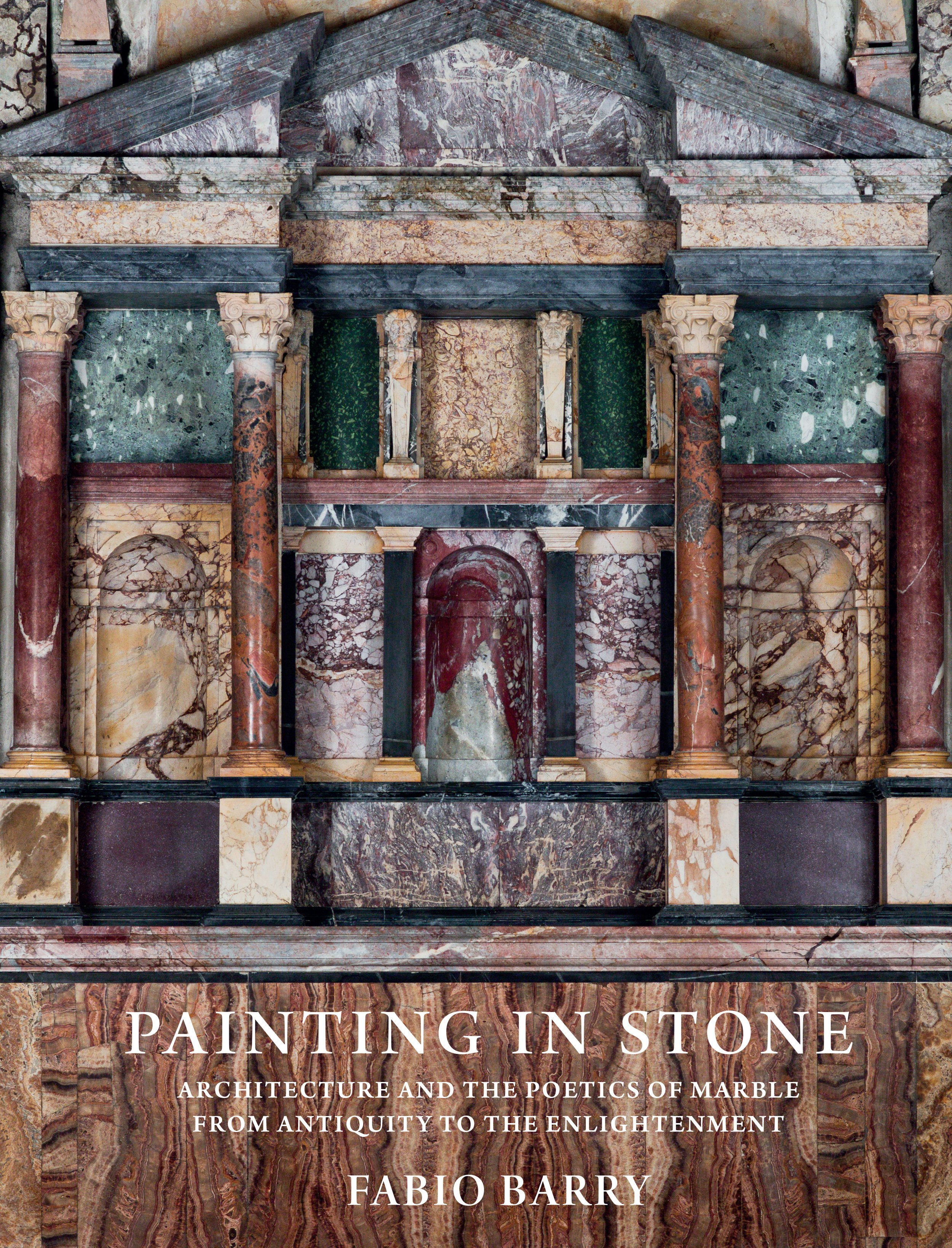Announcement of the 2021 SAHGB Award Winners
We are pleased to congratulate the winners of this year’s awards.
Alice Davis Hitchcock Medallion
Awarded annually since 1959 to a monograph that makes an outstanding contribution to the study or knowledge of architectural history.
This year’s winners are:
Fabio Barry’s Painting in Stone. Architecture and the Poetics of Marble from Antiquity to the Enlightenment (Yale University Press) - which the panel commend as a landmark work, beautifully written, methodologically innovative and which will have significant impact on future studies.
and
Sugata Ray’s Climate Change and the Art of Devotion. Geoaeshetics in the Land of Krishna 1550-1850 (University of Washington Press). The panel recognized the innovative and paradigm shifting nature of this book, the author’s command and synthesis of multiple epistemologies that connected architecture and the environment, and its potential to open up avenues for architectural history as a global discipline.
Elizabeth Darling, on behalf of the judging panel, commented:
“The judges for this year’s ADH Medallion had shortlisted six books which represented the diversity and range of the discipline as it currently stands. From an encyclopaedic study of global housing to an analysis of key building types of the British twentieth century, from a study of gender, space and authority in the Anglo-Norman world to the politics of the architecture of Irish courthouses and gaols, to a consideration of the symbolism of marble in architecture from Antiquity to the Enlightenment and an exposition of eco-aesthetics through a study of religious sites in North India, the panel read work that represented the many avenues that architectural historians can explore.
“After much discussion, the panel agreed that this year it would award the Medallion to two authors. They were chosen for the different and diverse ways they challenged what architectural history could and should be”.
Painting in Stone is published by Yale University Press.
Climate Change and the Art of Devotion is published by the University of Washington Press.
Colvin Prize
Awarded annually to the author or authors of an outstanding work of reference of use and value to architectural historians and the discipline of architectural history, across a range of formats.
This year’s winner is:
Alec Hamilton, Arts and Crafts Churches (Lund Humphries Publishers Ltd).
Frances Sands, on behalf of the judging panel, commented:
“Scholarship on the Arts and Crafts movement has tended to focus on domestic architecture, whereas this publication delves into the realm of Britain’s Arts and Crafts churches. It provides helpful explanatory, analytical and contextual information in Part I, while Part II contains an impressive gazetteer of over 200 churches, mostly built between 1884 and 1918. Many of these churches are richly ornamented both externally and internally, and the author describes them as ‘often quaint, at times far-fetched and capricious’, giving a glimpse of the fun to be had reading this volume. Moreover, these churches offer a fascinating narrative about religion and ecclesiastical architecture in Britain at the dawn of modernity and of greater religious ambivalence.
“The judging panel admired Hamilton’s work greatly, and found it to be a beautifully presented and entertainingly written volume which communicates well to both non-specialist and academic audiences. It is full of interest and scholarship and breaks new ground on a subject about which there is relatively little written. Part I contains a brilliantly conceived opening series of contextual chapters, providing a fulsome definition of Arts and Crafts architecture, and which are full of impressive scholarship, coherent synthesis, and valuable new findings. Part II, containing the gazetteer, is similar in some ways to a Pevsner volume, with its individual building entries arranged by location. Each geographical region within the gazetteer is given an introductory essay and points the reader towards key Arts and Crafts churches of the area. This is followed by discussive building entries on certain churches, as well as a list of others. Both the full entries and the lists include significant details such as dates of construction and the architects involved, providing a robust reference resource. The author has an engaging writing style and the longer entries don't feel overloaded with detail. It is also beautifully produced with full colour illustrations and a generous layout. Despite this and the hardback format, the volume is keenly priced and will likely appeal well beyond specialist audiences and have a wide reach”.
Arts and Crafts Churches is published by Lund Humphries Publishers.
Heritage Research Award
The SAHGB-IHBC Heritage Research Award recognises and celebrates the quality of architectural-historical research produced by colleagues in heritage and conservation practice, as private consultants and in non-departmental public bodies.
Winning Research:
An Architectural History of the Lord Leycester Hospital, Warwick: Produced by Ben Clark, Donald Insall Associates
Simon Green, on behalf of the judging panel, commented:
“The panel agreed to award the first SAHGB Heritage Research Award to ‘An Architectural History of Lord Leycester Hospital’ from a strong and varied field of entries.
“After much discussion it felt that the research purpose was clearly defined to inform the preparation of a Conservation Management Plan and a baseline gazetteer. It also felt that the sources consulted were well referenced and the links between the documentary evidence and on-site observation clearly explained. The research also unearthed new evidence form secondary sources. The outcome is a record of chronological development of the site and analysis of significance to inform policies to guide the future management of the site. The panel however felt that a phased plan and more detailed illustration captions would have enhanced the understanding of this complex series of buildings”.
Highly Commended:
Historic Railings of Central Oxford: Produced by David Clark on behalf of The Oxford Preservation Trust
Lone Le Vay, on behalf of the judging panel, commented:
“The panel felt that this was a pioneering study of an important aspect of the public realm of Central Oxford based on meticulous research and observation. Drawing on archival research, old photographs and drawings, the panel considered this to be a very useful, thorough, detailed, and well-presented study. The research covers new ground and contributes to much needed understanding of the historic development of the railings and also the materials and blacksmiths involved in their manufacture. While it was felt that the study would have benefited from a phased map or plan to enable clearer understanding of the location and relationship of the railings studied, we considered the research’s strength to be in the breadth of the survey and the depth of information provided”.
Hawksmoor Essay Prize
Awarded to the author of the best essay submitted in competition, and aimed at graduate students, early career researchers and professionals in architectural history, heritage and conservation practice.
This year’s winner is:
Rosanna Barraclough (University of Cambridge), Architectural identity, patronage and legacy in Joseph Bonomi the Elder’s country houses and estates c.1781-1808
Mark Swenarton, on behalf of the judging panel, commented:
“In the early nineteenth century Joseph Bonomi the Elder (1739-1808) was one of the best-known architects in Britain – so much so that he figured in Jane Austen’s Sense and Sensibility – but his reputation subsequently declined and diminished, to the extent that in the current literature on British architecture of the nineteenth century he is little more than a footnote. This has validated demolition of some of his most important work – above all Rosneath Castle in Dunbartonshire – on the grounds that it was designed by an architect of little importance, which in turn makes it all the harder to recapture and appraise the qualities of his architecture. With commendable zeal, this essay sets about exploring the reasons for this excision and setting it to rights. Drawing on the limited available evidence but also, crucially, the hitherto unused drawings of Rosneath in the Argyll archive, the essay repositions Bonomi as an Italian architect working in London – first for the Adam Brothers and then on his own account – and explores both the nature of his architecture and the factors that led to his exclusion from the inner circle of the establishment, notably the Royal Academy. In doing so, it sheds new light as much on developments in neoclassicism in this period – specifically the ‘stripped down’ style that Bonomi espoused – as on the xenophobic and anti-Catholic currents in London architecture at the time. Combining historical and historiographical revision in a subtle and nuanced manner, this elegantly written and presented essay was applauded by the judges as a work of remarkable maturity and insight for someone at the outset of their career”.
Commended:
Alborz Dianat (University of Edinburgh), The network of a British-European: P. Morton Shand, modernism’s persona grata
Mark Swenarton commented: “The judges commended this essay for its impressive use of important, and previously unavailable, archival material and also for the clarity of the writing and structure. The essay marshals a large body of primary material to provide an engaging and intelligent exploration of the rise, formalisation and decline of Morton Shand’s European networking activities in the interwar period. The essay also displays a commendable self-awareness in understanding the limitations of what is achievable within the confines of a short essay and very usefully lays the groundwork for future research and analysis”.
Commended:
Tommaso Zerbi (University of Edinburgh), The Making of Italy (through the Ephemeral): The First Italian Parliament between State Building, ‘Risorgimental NeoMedievalism’, and Glorification of the House of Savoy
Mark Swenarton commented: “The essay offers an in-depth study of an important, but hitherto overlooked, state building and uses it as a springboard for the exploration of the wider role of neo-medievalism in Italian nation-formation in the mid-nineteenth century. The judges considered it a very good and timely exploration of the subject, which is well situated within multiple historiographies. The core questions are intelligently conceived and explored through a well-structured argument, combining political-historical discussion with architectural analysis”.
Dissertation Prize
This prize celebrates the outstanding work in architectural history being carried out by postgraduate students on taught Masters-level courses in UK universities. The prize awards innovative and critical thinking in and around the subject of Architectural History, broadly conceived, which supports the Society’s aim to help create ‘a bigger discipline’.
This year’s winner is Filippos Toskas.
The SAHGB’s internationally prestigious awards programme celebrates the best in research and publishing in architectural history. It is open and inclusive, celebrating diversity of approach in histories of the built environment as broadly conceived. You do not need to be a member to nominate or be nominated.
Full lists of the judging panels for this year’s prizes can be found here, alongside more information on the awards programme, including how to nominate works.



